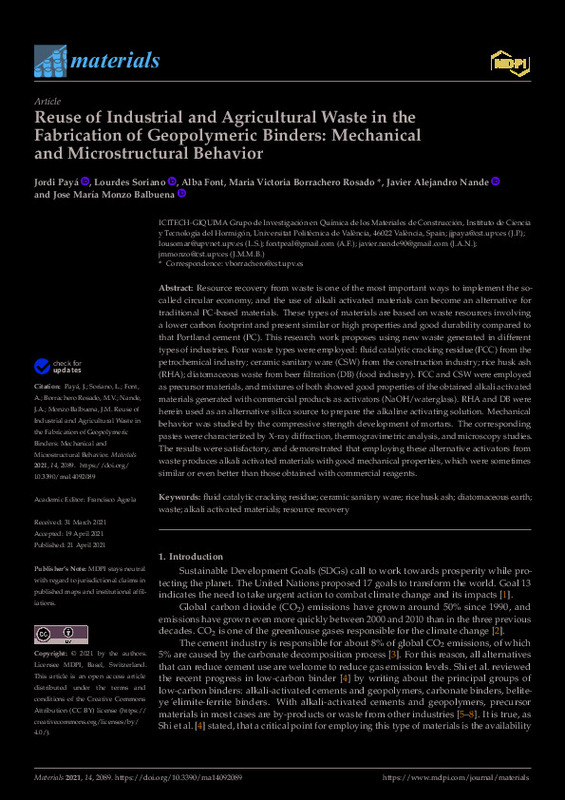JavaScript is disabled for your browser. Some features of this site may not work without it.
Buscar en RiuNet
Listar
Mi cuenta
Estadísticas
Ayuda RiuNet
Admin. UPV
Reuse of industrial and agricultural waste in the fabrication of geopolymeric binders: mechanical and microstructural behavior
Mostrar el registro sencillo del ítem
Ficheros en el ítem
| dc.contributor.author | Paya Bernabeu, Jorge Juan
|
es_ES |
| dc.contributor.author | Soriano Martinez, Lourdes
|
es_ES |
| dc.contributor.author | Font, Alba
|
es_ES |
| dc.contributor.author | Borrachero Rosado, María Victoria
|
es_ES |
| dc.contributor.author | Nande, Javier Alejandro
|
es_ES |
| dc.contributor.author | Monzó Balbuena, José Mª
|
es_ES |
| dc.date.accessioned | 2022-09-30T18:07:11Z | |
| dc.date.available | 2022-09-30T18:07:11Z | |
| dc.date.issued | 2021-04-21 | es_ES |
| dc.identifier.uri | http://hdl.handle.net/10251/186803 | |
| dc.description.abstract | [EN] Resource recovery from waste is one of the most important ways to implement the socalled circular economy, and the use of alkali activated materials can become an alternative for traditional PC-based materials. These types of materials are based on waste resources involving a lower carbon footprint and present similar or high properties and good durability compared to that Portland cement (PC). This research work proposes using new waste generated in different types of industries. Four waste types were employed: fluid catalytic cracking residue (FCC) from the petrochemical industry; ceramic sanitary ware (CSW) from the construction industry; rice husk ash (RHA); diatomaceous waste from beer filtration (DB) (food industry). FCC and CSW were employed as precursor materials, and mixtures of both showed good properties of the obtained alkali activated materials generated with commercial products as activators (NaOH/waterglass). RHA and DB were herein used as an alternative silica source to prepare the alkaline activating solution. Mechanical behavior was studied by the compressive strength development of mortars. The corresponding pastes were characterized by X-ray diffraction, thermogravimetric analysis, and microscopy studies. The results were satisfactory, and demonstrated that employing these alternative activators from waste produces alkali activated materials with good mechanical properties, which were sometimes similar or even better than those obtained with commercial reagents. | es_ES |
| dc.description.sponsorship | This research was funded by the Spanish Government and FEDER funds (MINECO/FEDERProject RTI2018-09612-B-C21). This research work forms part of a project supported by MINECO and FEDER funds (ECOSOST RTI2018-097612-B-C21). | es_ES |
| dc.language | Inglés | es_ES |
| dc.publisher | MDPI AG | es_ES |
| dc.relation.ispartof | Materials | es_ES |
| dc.rights | Reconocimiento (by) | es_ES |
| dc.subject | Fluid catalytic cracking residue | es_ES |
| dc.subject | Ceramic sanitary ware | es_ES |
| dc.subject | Rice husk ash | es_ES |
| dc.subject | Diatomaceous earth | es_ES |
| dc.subject | Waste | es_ES |
| dc.subject | Alkali activated materials | es_ES |
| dc.subject | Resource recovery | es_ES |
| dc.subject.classification | INGENIERIA DE LA CONSTRUCCION | es_ES |
| dc.title | Reuse of industrial and agricultural waste in the fabrication of geopolymeric binders: mechanical and microstructural behavior | es_ES |
| dc.type | Artículo | es_ES |
| dc.identifier.doi | 10.3390/ma14092089 | es_ES |
| dc.relation.projectID | info:eu-repo/grantAgreement/AEI/Plan Estatal de Investigación Científica y Técnica y de Innovación 2017-2020/RTI2018-097612-B-C21/ES/NUEVOS RETOS EN CEMENTOS ACTIVADOS ALCALINAMENTE:SOSTENIBILIDAD Y EVALUACION AMBIENTAL/ | es_ES |
| dc.relation.projectID | info:eu-repo/grantAgreement/MINECO//RTI2018-09612-B-C21/ | es_ES |
| dc.rights.accessRights | Abierto | es_ES |
| dc.contributor.affiliation | Universitat Politècnica de València. Departamento de Ingeniería de la Construcción y de Proyectos de Ingeniería Civil - Departament d'Enginyeria de la Construcció i de Projectes d'Enginyeria Civil | es_ES |
| dc.description.bibliographicCitation | Paya Bernabeu, JJ.; Soriano Martinez, L.; Font, A.; Borrachero Rosado, MV.; Nande, JA.; Monzó Balbuena, JM. (2021). Reuse of industrial and agricultural waste in the fabrication of geopolymeric binders: mechanical and microstructural behavior. Materials. 14(9):1-13. https://doi.org/10.3390/ma14092089 | es_ES |
| dc.description.accrualMethod | S | es_ES |
| dc.relation.publisherversion | https://doi.org/10.3390/ma14092089 | es_ES |
| dc.description.upvformatpinicio | 1 | es_ES |
| dc.description.upvformatpfin | 13 | es_ES |
| dc.type.version | info:eu-repo/semantics/publishedVersion | es_ES |
| dc.description.volume | 14 | es_ES |
| dc.description.issue | 9 | es_ES |
| dc.identifier.eissn | 1996-1944 | es_ES |
| dc.identifier.pmid | 33919008 | es_ES |
| dc.identifier.pmcid | PMC8122445 | es_ES |
| dc.relation.pasarela | S\459101 | es_ES |
| dc.contributor.funder | AGENCIA ESTATAL DE INVESTIGACION | es_ES |
| dc.contributor.funder | Agencia Estatal de Investigación | es_ES |
| dc.contributor.funder | European Regional Development Fund | es_ES |
| dc.contributor.funder | Ministerio de Economía y Competitividad | es_ES |
| dc.subject.ods | 09.- Desarrollar infraestructuras resilientes, promover la industrialización inclusiva y sostenible, y fomentar la innovación | es_ES |
| dc.subject.ods | 11.- Conseguir que las ciudades y los asentamientos humanos sean inclusivos, seguros, resilientes y sostenibles | es_ES |








